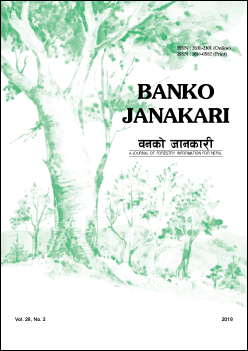Looking women seriously: what makes differences for women participation in community forestry ?
DOI:
https://doi.org/10.3126/banko.v28i2.24184Keywords:
Community forestry, decision making, gender, participationAbstract
Women participation has been in discussion for long in community forestry in Nepal - a successful programme in participatory forest governance. Despite having ample of policy instruments to address the women concern in community forestry decision making activities several pragmatic issues have been encountered. This paper examines on the women participation in different community forestry decision making activities and identifies the factors influencing participation in such activities. The evidences were generated from five community forest user groups in Kaski district. The analysis was based on the household surveys that included the random sample of 213 respondents (107 females and 106 males). Similarly, regular triangulation and verification of the data were made through series of interviews, discussions and observations followed by the analysis of CF documents. Three ordered logit regression models were deployed to examine the determinants of women participation in decision making in forest management, resource utilization and participatory activities. The analysis showed lower participation of women in community forest decision making activities. Gender had the significant association with the participation in all decision making activities. The men with higher education, who are the member of executive committee and have access to community forestry fund, had participated significantly more than women in community forestry decision making activities. Low participation of women was associated with lower representation in user group committee, social and traditional beliefs and preoccupied assumption that women cannot lead which may result in unfair implication of community forestry.
Downloads
Downloads
Published
How to Cite
Issue
Section
License
© Forest Research and Training Center




